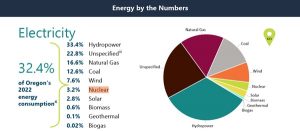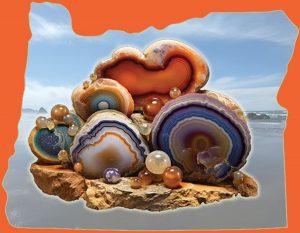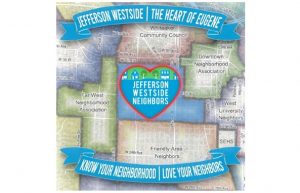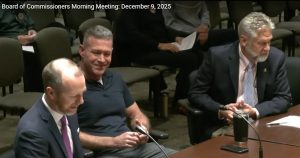EWEB: Our federal partners let us down
4 min read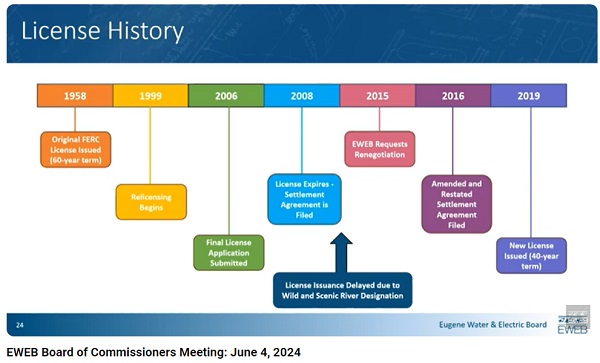
EWEB board members say our federal partners are failing us. Long delays on the Carmen-Smith hydro project could cost ratepayers another $55 million. Under questioning from a board member, EWEB’s generation manager acknowledged a Forest Service mapping issue caused a seven-year delay.
[00:00:18] Lisa Krentz (EWEB generation manager): The initial 2016 project estimate: $139 million… Our current estimate: …$194 million (that does also include powerhouse upgrades)…
[00:00:29] So overall, schedule delays have not been our friend. They have made us susceptible to inflation and supply chain issues. And then there’s dam safety concerns, both known and emergent, that have expanded the scope of many projects…
[00:00:44] The existing license expired in 2008… license issuance was held up for many years due to a discrepancy in the ‘Wild and Scenic River’ designation, which was essentially a jurisdictional issue between the FERC and the U.S. Forest Service and not something within EWEB’s control.
[00:01:01] John Q: Commissioner Sonya Carlson asked Lisa about that jurisdictional issue.
[00:01:05] Lisa Krentz (EWEB generation manager): So there was a discrepancy in the way the ‘Wild and Scenic River’ was mapped. So, that’s what caused the delay is the time, that delay between 2008 and 2015.
[00:01:17] Sonya Carlson (EWEB commissioner): Who makes that?
[00:01:19] Lisa Krentz (EWEB generation manager): I’m sorry, what?
[00:01:19] Sonya Carlson (EWEB commissioner): Who makes that? Who, who makes that determination, that mapping?
[00:01:22] Lisa Krentz (EWEB generation manager): It’s the Forest Service and the
[00:01:24] Sonya Carlson (EWEB commissioner): The Forest Service.
[00:01:25] Lisa Krentz (EWEB generation manager): Yeah.
[00:01:25] Sonya Carlson (EWEB commissioner): So they’re the ones that made a mistake that then caused this designation to screw up our licensing plan. I just want to get it clear.
[00:01:32] Lisa Krentz (EWEB generation manager): Yep, that’s correct.
[00:01:32] John Q: Lisa also pointed out issues with the Federal Energy Regulatory Commission (FERC).
[00:01:37] Lisa Krentz (EWEB generation manager): A point to clarify here is, FERC is, they’re a multientity organization as well. They have a Division of Hydropower and Compliance and they have a Division of Dam Safety, both with separate missions, essentially, right?
[00:01:51] We work very closely with the Division of Dam Safety. That is where we have our primary points of contact in trying to work through the dam safety issues.
[00:02:00] The Division of Hydropower and Compliance, or DHAC, they’re still tasked with administering the license requirements.
[00:02:06] And so, and there is this absolute conflict between dam safety requirements and our license requirements and so FERC in and of itself are a bit at odds with each other.
[00:02:19] Sonya Carlson (EWEB commissioner): Sure, and you know, they’re a federal agency that is massive. I mean, we issued the application and it took three years for them to approve it.
[00:02:27] John Q: EWEB says, ‘Complying with FERC dam safety requirements is causing us to be out of compliance with other FERC requirements.’ Commissioner John Brown threw in another culprit: the engineers.
[00:02:38] John Brown (EWEB commissioner): Okay, and the $194 million assumes what fish passage?
[00:02:42] Lisa Krentz (EWEB generation manager): It assumes the current requirements in the license, which is trap and haul.
[00:02:47] John Brown (EWEB commissioner): Okay. And when I was on the Board when we were talking about the fish ladder, the engineers couldn’t figure out how it would work because on the far side opposite highway is where it was going to come over and the drop was too much. And they were going to compromise the integrity of—they couldn’t figure out, Engineering, how to do it. They were just fuddled, and has anything changed? Because they said it would be the longest passage of anything in the Northwest and they didn’t know if the fish would even use it. But they were more worried about dam safety, about when they had to dig into the mountain wall to have the fish ladder come there because of the fluctuation level of that, they said it would be a 14-foot drop and would kill the fish.
[00:03:29] John Q: The engineers designed a next-generation device.
[00:03:33] John Brown (EWEB commissioner): We had to build a downstream filter, basically a trap, and that was totally untested technology and they didn’t know if it would work. And it was like $40 or $50 million and they had no idea. It was going to be floating and they were going to trap the fish. And it was a pretty Star Wars type of thing, you know, that nobody knew even how to design it, let alone construct it.
[00:03:54] John Q: EWEB says ratepayers now face additional costs from delays and federal ‘Star Wars’ projects. We asked the Forest Service: Why should EWEB ratepayers have to pay an extra $55 million (and climbing), because it took your agencies seven years to resolve a mapping issue?

